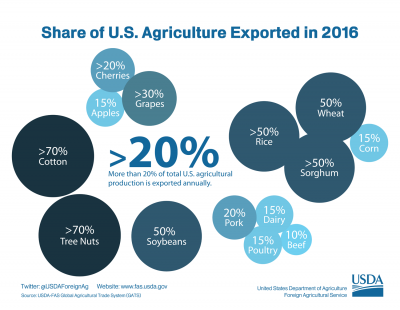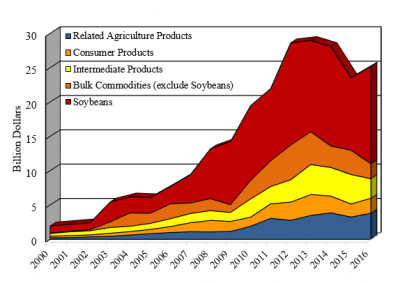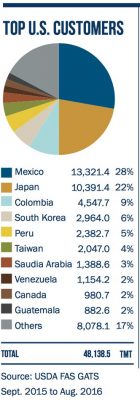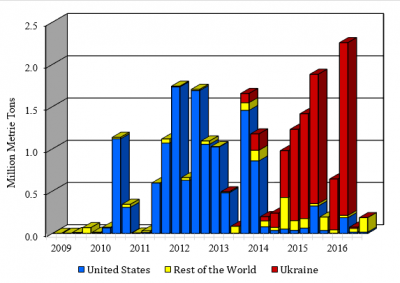Bloomberg's Clarice Couto reported this past Friday that "a surprising tax change in agriculture powerhouse Brazil has the potential to make soy grown in the world’s largest bean exporter less…
U.S. Ag Exports to China: Soybeans and Corn
Background
Mary A. Marchant indicated recently at Choices Online that, “International trade deficits have recently been reputed as ‘bad’ for the economy; however, agriculture has posted a trade surplus since 1959. For U.S. agriculture, trade represents 20% of farmers’ income on average, and more for specific commodities—70% for cotton and tree nuts; 50% for wheat, rice, and soybeans: and almost 20% for meat and dairy products. Thus, tossing trade would be comparable to U.S. farmers destroying 20% of their yields. China, which has advanced to become the United States’ largest agricultural export market in an unprecedented time frame, plays a key role in the economic wellbeing of U.S. agriculture.”

“In 2012, China surpassed Canada to become the leading market for U.S. agricultural exports. As China has one-fifth of the world’s consumers but one-tenth of the world’s arable land, the potential is considerable for China’s continued growth as an importer of U.S. agricultural products. From China’s perspective, the U.S. is its leading supplier of agricultural imports. China has adopted more open trade policies since joining the World Trade Organization while—at the same time—enacting policies that promote food security, price stability, and higher incomes for farmers. These policies have led to increased price distortions between Chinese and international markets.”

Soybeans
More specifically, a related Choices update (“U.S. Agricultural Exports to China Increased Rapidly Making China the Number One Market“) explained that, “Strong growth in U.S. exports to China reflects significant changes in China’s domestic policies, which have created a more market-oriented economy with market-determined prices, and changing consumer preferences as incomes increased. China’s policies on trade, domestic agriculture, and food security have greatly affected trade with the United States. In China, strong income growth, increasing urbanization, an emerging middle class, and growing concerns about food safety have meant more diverse U.S. exports, including greater numbers of valued-added products.
The greatest growth in U.S. exports to China has been in commodities that do not conflict with China’s domestic policies for maintaining self-sufficiency and are in short supply. The best example is soybeans, which are needed for China’s expanding livestock industry.
The Choices article added that, “China’s livestock sector has evolved from backyard production to large-scale commercialized operations, which increased demand for soybean meal in feed rations at a faster rate than the growth in domestic meat production. Although demand for soybean meal for livestock feed increased, China’s soybean production has not expanded over the past 20 years, but decreased. Soybean yield growth stagnated from 1996 to 2016. The area planted to soybeans declined from 2009–2015 due to lower profitability compared to alternative crops, such as corn, which have been supported by government programs and policies. There have been almost no constraints or restrictions on soybean imports.”

Corn
In a closer look at corn trade with the China, the Choices article stated that, “Many commodity analysts expected China to be a major importer of corn due to increasing feed demand for its growing livestock sector and expectations of a limited ability to expand the area under corn production. However, China did not begin to significantly import corn until 2011/12, with 5.2 million metric tons. Since then, China has only averaged 3.8 million tons per year. In contrast, Japan and Mexico each import at about 14 million metric tons per year.”

“Many analysts thought corn area could not be expanded, but since 2000/01, China’s corn area increased from 23 million hectares to 38 million hectares by 2015/16. Corn production doubled over this time period.
Expanded planting area was driven by government policies setting high procurement prices and import restrictions on corn, enabling corn to be more profitable than competing crops, such as soybeans.
“Much of the new corn area was achieved by expanding into marginal areas, especially in Northeast China.”
Furthermore, the Choices article noted that, “The United States also faces strong competition in exporting corn to China. Beginning in 2014, Ukraine became the major exporter of corn to China. In 2012, Ukraine and China signed a loan-for-crops contract worth $3 billion, which provided credit to Ukraine in exchange for corn supplies to China. Increased imports from Ukraine may also be part of China’s new Silk Road plan, which is meant to revitalize trade with Europe and neighboring Asian countries and to diversify China’s import suppliers. Even though U.S. corn was priced lower in late 2014 and 2015, China significantly increased corn imports from Ukraine due to the financial risk of U.S. corn imports being rejected due to unapproved biotech traits.”

Trade- A High Priority for Agriculture
And Santiago Kahn reported this week at KSNW-TV Online (Wichita, Kansas) that, [House Ag Committee Member Roger Marshall (R., Kans.) is looking at ways to increase farmers’ revenues rather than cover their losses.
“‘It’s all about the price of wheat, the price of cattle, and what can I do to improve it.’
He believes at this point, trade deals are more important than the farm bill.
The update added that, “‘It’s very important,’ he said about the farm bill, ‘but I’m not worried about it, versus trade is in a state of disarray, and we need to be focused on that.’
“Marshall hopes to address the low commodity prices by finding more customers, like in China.
“‘We’ll start selling beef there in July for the first time in over a decade,’ he said. ‘Obviously it’s a huge market.'”







